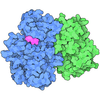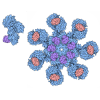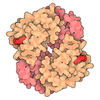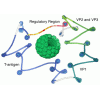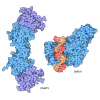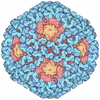[English] 日本語
 Yorodumi
Yorodumi- PDB-9c8u: Human PRC2 - RvLEAM (short) (1:6 molar ratio), cross-linked 10 min -
+ Open data
Open data
- Basic information
Basic information
| Entry | Database: PDB / ID: 9c8u | ||||||||||||
|---|---|---|---|---|---|---|---|---|---|---|---|---|---|
| Title | Human PRC2 - RvLEAM (short) (1:6 molar ratio), cross-linked 10 min | ||||||||||||
 Components Components |
| ||||||||||||
 Keywords Keywords | DNA BINDING PROTEIN / Human polycomb repressive complex 2 / RvLEAM / air-water-interface | ||||||||||||
| Function / homology |  Function and homology information Function and homology informationprotein localization to pericentric heterochromatin / hepatocyte homeostasis / cellular response to trichostatin A / regulation of gliogenesis / negative regulation of striated muscle cell differentiation / regulation of kidney development / [histone H3]-lysine27 N-trimethyltransferase / response to tetrachloromethane / CAF-1 complex / negative regulation of keratinocyte differentiation ...protein localization to pericentric heterochromatin / hepatocyte homeostasis / cellular response to trichostatin A / regulation of gliogenesis / negative regulation of striated muscle cell differentiation / regulation of kidney development / [histone H3]-lysine27 N-trimethyltransferase / response to tetrachloromethane / CAF-1 complex / negative regulation of keratinocyte differentiation / histone H3K27 trimethyltransferase activity / negative regulation of retinoic acid receptor signaling pathway / cerebellar cortex development / primary miRNA binding / random inactivation of X chromosome / regulation of adaxial/abaxial pattern formation / skeletal muscle satellite cell maintenance involved in skeletal muscle regeneration / regulatory ncRNA-mediated heterochromatin formation / negative regulation of cardiac muscle cell proliferation / histone H3K27 methyltransferase activity / sex chromatin / ubiquitin-modified histone reader activity / positive regulation of cell cycle G1/S phase transition / NURF complex / facultative heterochromatin formation / NuRD complex / regulation of cell fate specification / negative regulation of stem cell population maintenance / genomic imprinting / DNA replication-dependent chromatin assembly / Transcription of E2F targets under negative control by p107 (RBL1) and p130 (RBL2) in complex with HDAC1 / ESC/E(Z) complex / negative regulation of stem cell differentiation / regulation of stem cell differentiation / RSC-type complex / protein-lysine N-methyltransferase activity / Polo-like kinase mediated events / cardiac muscle hypertrophy in response to stress / chromatin silencing complex / histone H3K9me2/3 reader activity / Transcription of E2F targets under negative control by DREAM complex / pronucleus / positive regulation of dendrite development / G1 to G0 transition / histone H3 methyltransferase activity / histone methyltransferase activity / DNA methylation-dependent constitutive heterochromatin formation / negative regulation of G1/S transition of mitotic cell cycle / spinal cord development / ATPase complex / lncRNA binding / negative regulation of gene expression, epigenetic / synaptic transmission, GABAergic / G1/S-Specific Transcription / Sin3-type complex / Transcriptional Regulation by E2F6 / : / positive regulation of stem cell population maintenance / positive regulation of MAP kinase activity / histone methyltransferase complex / oligodendrocyte differentiation / RNA Polymerase I Transcription Initiation / histone deacetylase complex / negative regulation of transcription elongation by RNA polymerase II / G0 and Early G1 / positive regulation of GTPase activity / positive regulation of protein serine/threonine kinase activity / negative regulation of cell differentiation / cardiac muscle cell proliferation / positive regulation of epithelial to mesenchymal transition / ribonucleoprotein complex binding / subtelomeric heterochromatin formation / pericentric heterochromatin / RNA polymerase II core promoter sequence-specific DNA binding / Cyclin E associated events during G1/S transition / Transcriptional regulation of brown and beige adipocyte differentiation by EBF2 / Cyclin A:Cdk2-associated events at S phase entry / nucleosome binding / keratinocyte differentiation / spleen development / Regulation of TP53 Activity through Acetylation / protein localization to chromatin / liver regeneration / negative regulation of cytokine production involved in inflammatory response / Deposition of new CENPA-containing nucleosomes at the centromere / negative regulation of cell migration / SUMOylation of chromatin organization proteins / thymus development / cellular response to leukemia inhibitory factor / central nervous system development / B cell differentiation / ubiquitin binding / Regulation of PTEN gene transcription / transcription corepressor binding / ERCC6 (CSB) and EHMT2 (G9a) positively regulate rRNA expression / PRC2 methylates histones and DNA / Regulation of endogenous retroelements by KRAB-ZFP proteins / Defective pyroptosis / transcription coregulator activity / hippocampus development Similarity search - Function | ||||||||||||
| Biological species |  Homo sapiens (human) Homo sapiens (human) | ||||||||||||
| Method | ELECTRON MICROSCOPY / single particle reconstruction / cryo EM / Resolution: 3.1 Å | ||||||||||||
 Authors Authors | Abe, K.M. / Li, G. / He, Q. / Grant, T. / Lim, C. | ||||||||||||
| Funding support |  United States, 3items United States, 3items
| ||||||||||||
 Citation Citation |  Journal: Nat Commun / Year: 2024 Journal: Nat Commun / Year: 2024Title: Small LEA proteins mitigate air-water interface damage to fragile cryo-EM samples during plunge freezing. Authors: Kaitlyn M Abe / Gan Li / Qixiang He / Timothy Grant / Ci Ji Lim /  Abstract: Air-water interface (AWI) interactions during cryo-electron microscopy (cryo-EM) sample preparation cause significant sample loss, hindering structural biology research. Organisms like nematodes and ...Air-water interface (AWI) interactions during cryo-electron microscopy (cryo-EM) sample preparation cause significant sample loss, hindering structural biology research. Organisms like nematodes and tardigrades produce Late Embryogenesis Abundant (LEA) proteins to withstand desiccation stress. Here we show that these LEA proteins, when used as additives during plunge freezing, effectively mitigate AWI damage to fragile multi-subunit molecular samples. The resulting high-resolution cryo-EM maps are comparable to or better than those obtained using existing AWI damage mitigation methods. Cryogenic electron tomography reveals that particles are localized at specific interfaces, suggesting LEA proteins form a barrier at the AWI. This interaction may explain the observed sample-dependent preferred orientation of particles. LEA proteins offer a simple, cost-effective, and adaptable approach for cryo-EM structural biologists to overcome AWI-related sample damage, potentially revitalizing challenging projects and advancing the field of structural biology. #1:  Journal: Science / Year: 2023 Journal: Science / Year: 2023Title: Structural basis for inactivation of PRC2 by G-quadruplex RNA. Authors: Jiarui Song / Anne R Gooding / Wayne O Hemphill / Brittney D Love / Anne Robertson / Liqi Yao / Leonard I Zon / Trista E North / Vignesh Kasinath / Thomas R Cech /  Abstract: Polycomb repressive complex 2 (PRC2) silences genes through trimethylation of histone H3K27. PRC2 associates with numerous precursor messenger RNAs (pre-mRNAs) and long noncoding RNAs (lncRNAs) with ...Polycomb repressive complex 2 (PRC2) silences genes through trimethylation of histone H3K27. PRC2 associates with numerous precursor messenger RNAs (pre-mRNAs) and long noncoding RNAs (lncRNAs) with a binding preference for G-quadruplex RNA. In this work, we present a 3.3-Å-resolution cryo-electron microscopy structure of PRC2 bound to a G-quadruplex RNA. Notably, RNA mediates the dimerization of PRC2 by binding both protomers and inducing a protein interface composed of two copies of the catalytic subunit EZH2, thereby blocking nucleosome DNA interaction and histone H3 tail accessibility. Furthermore, an RNA-binding loop of EZH2 facilitates the handoff between RNA and DNA, another activity implicated in PRC2 regulation by RNA. We identified a gain-of-function mutation in this loop that activates PRC2 in zebrafish. Our results reveal mechanisms for RNA-mediated regulation of a chromatin-modifying enzyme. | ||||||||||||
| History |
|
- Structure visualization
Structure visualization
| Structure viewer | Molecule:  Molmil Molmil Jmol/JSmol Jmol/JSmol |
|---|
- Downloads & links
Downloads & links
- Download
Download
| PDBx/mmCIF format |  9c8u.cif.gz 9c8u.cif.gz | 355.4 KB | Display |  PDBx/mmCIF format PDBx/mmCIF format |
|---|---|---|---|---|
| PDB format |  pdb9c8u.ent.gz pdb9c8u.ent.gz | 260.1 KB | Display |  PDB format PDB format |
| PDBx/mmJSON format |  9c8u.json.gz 9c8u.json.gz | Tree view |  PDBx/mmJSON format PDBx/mmJSON format | |
| Others |  Other downloads Other downloads |
-Validation report
| Summary document |  9c8u_validation.pdf.gz 9c8u_validation.pdf.gz | 1.1 MB | Display |  wwPDB validaton report wwPDB validaton report |
|---|---|---|---|---|
| Full document |  9c8u_full_validation.pdf.gz 9c8u_full_validation.pdf.gz | 1.1 MB | Display | |
| Data in XML |  9c8u_validation.xml.gz 9c8u_validation.xml.gz | 58.2 KB | Display | |
| Data in CIF |  9c8u_validation.cif.gz 9c8u_validation.cif.gz | 89.6 KB | Display | |
| Arichive directory |  https://data.pdbj.org/pub/pdb/validation_reports/c8/9c8u https://data.pdbj.org/pub/pdb/validation_reports/c8/9c8u ftp://data.pdbj.org/pub/pdb/validation_reports/c8/9c8u ftp://data.pdbj.org/pub/pdb/validation_reports/c8/9c8u | HTTPS FTP |
-Related structure data
| Related structure data |  43625MC  8vy3C  9c8vC M: map data used to model this data C: citing same article ( |
|---|---|
| Similar structure data | Similarity search - Function & homology  F&H Search F&H Search |
- Links
Links
- Assembly
Assembly
| Deposited unit | 
|
|---|---|
| 1 |
|
- Components
Components
-Polycomb protein ... , 2 types, 2 molecules BC
| #1: Protein | Mass: 83181.922 Da / Num. of mol.: 1 Source method: isolated from a genetically manipulated source Source: (gene. exp.)  Homo sapiens (human) / Gene: SUZ12, CHET9, JJAZ1, KIAA0160 / Production host: Homo sapiens (human) / Gene: SUZ12, CHET9, JJAZ1, KIAA0160 / Production host:  |
|---|---|
| #2: Protein | Mass: 42386.273 Da / Num. of mol.: 1 Source method: isolated from a genetically manipulated source Source: (gene. exp.)  Homo sapiens (human) / Gene: EED / Production host: Homo sapiens (human) / Gene: EED / Production host:  |
-Protein , 3 types, 3 molecules DAF
| #3: Protein | Mass: 47709.527 Da / Num. of mol.: 1 Source method: isolated from a genetically manipulated source Source: (gene. exp.)  Homo sapiens (human) / Gene: RBBP4, RBAP48 / Production host: Homo sapiens (human) / Gene: RBBP4, RBAP48 / Production host:  |
|---|---|
| #4: Protein | Mass: 86017.859 Da / Num. of mol.: 1 Source method: isolated from a genetically manipulated source Source: (gene. exp.)  Homo sapiens (human) / Gene: EZH2, KMT6 / Production host: Homo sapiens (human) / Gene: EZH2, KMT6 / Production host:  References: UniProt: Q15910, [histone H3]-lysine27 N-trimethyltransferase |
| #6: Protein | Mass: 32881.473 Da / Num. of mol.: 1 Source method: isolated from a genetically manipulated source Source: (gene. exp.)  Homo sapiens (human) / Gene: AEBP2 / Production host: Homo sapiens (human) / Gene: AEBP2 / Production host:  |
-Protein/peptide / Non-polymers , 2 types, 8 molecules E

| #5: Protein/peptide | Mass: 3436.009 Da / Num. of mol.: 1 Source method: isolated from a genetically manipulated source Source: (gene. exp.)  Homo sapiens (human) / Gene: JARID2, JMJ / Production host: Homo sapiens (human) / Gene: JARID2, JMJ / Production host:  |
|---|---|
| #7: Chemical | ChemComp-ZN / |
-Details
| Has ligand of interest | N |
|---|---|
| Has protein modification | Y |
-Experimental details
-Experiment
| Experiment | Method: ELECTRON MICROSCOPY |
|---|---|
| EM experiment | Aggregation state: PARTICLE / 3D reconstruction method: single particle reconstruction |
- Sample preparation
Sample preparation
| Component | Name: Polycomb Repressive Complex 2 / Type: COMPLEX / Entity ID: #1-#6 / Source: RECOMBINANT |
|---|---|
| Molecular weight | Experimental value: NO |
| Source (natural) | Organism:  Homo sapiens (human) Homo sapiens (human) |
| Source (recombinant) | Organism:  |
| Buffer solution | pH: 7.5 |
| Specimen | Embedding applied: NO / Shadowing applied: NO / Staining applied: NO / Vitrification applied: YES |
| Vitrification | Cryogen name: ETHANE |
- Electron microscopy imaging
Electron microscopy imaging
| Experimental equipment | 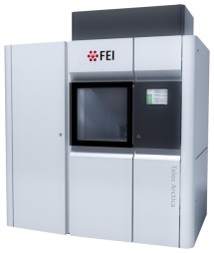 Model: Talos Arctica / Image courtesy: FEI Company |
|---|---|
| Microscopy | Model: FEI TALOS ARCTICA |
| Electron gun | Electron source:  FIELD EMISSION GUN / Accelerating voltage: 200 kV / Illumination mode: FLOOD BEAM FIELD EMISSION GUN / Accelerating voltage: 200 kV / Illumination mode: FLOOD BEAM |
| Electron lens | Mode: BRIGHT FIELD / Nominal defocus max: 2500 nm / Nominal defocus min: 1000 nm |
| Specimen holder | Cryogen: NITROGEN |
| Image recording | Electron dose: 50 e/Å2 / Film or detector model: GATAN K3 BIOQUANTUM (6k x 4k) |
- Processing
Processing
| EM software | Name: PHENIX / Category: model refinement |
|---|---|
| CTF correction | Type: NONE |
| 3D reconstruction | Resolution: 3.1 Å / Resolution method: FSC 0.143 CUT-OFF / Num. of particles: 366459 / Symmetry type: POINT |
 Movie
Movie Controller
Controller











 PDBj
PDBj
